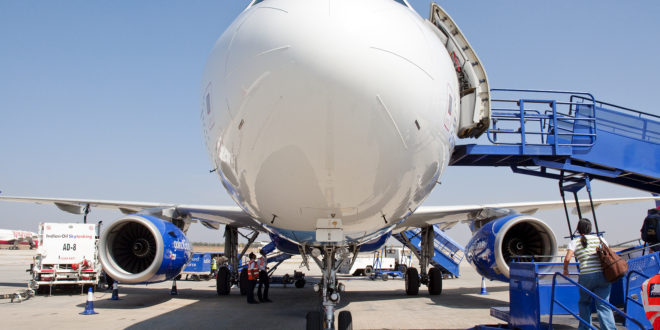Indigo by any standard is a phenomenal success story. Starting out as the third player (after GoAir and SpiceJet) in 2005, it has captured a marketshare that is likely to cross 45% soon. Bangalore Aviation presents analysis on the company and where it will likely head:
Capacity growth
| Indigo | FY13 | FY14 | FY15 | FY16 | FY17E |
| Fleet growth | Base | 17% | 22% | 14% | 21% |
| Utilization growth | Base | 21% | -5% | 5% | 3% |
| Dom capacity growth | Base | 21% | 22% | 22% | 30% |
| Intl Capacity growth | Base | 13% | -7% | 13% | 18% |
| Total Capacity growth | Base | 20% | 18% | 21% | 29% |
Source: DGCA, Company filings, Bangalore Aviation research
Capacity growth has been aggressive. Additionally, Indigo has focused on effective utilization. Utilization is lower than some of its peers (GoAir and Jet Airways) but this is a conscious decision where Indigo has catered for its larger fleet size and also sizeable presence at airports that impact on-time performance.
Capacity utilization
| Indigo | FY13 | FY14 | FY15 | FY16 | FY17E |
| RPKM domestic | Base | 15% | 27% | 29% | 27% |
| RPKM Intl | Base | 11% | -6% | 13% | 12% |
| RPKM total | Base | 14% | 22% | 28% | 25% |
Source: DGCA, Company filings, Bangalore Aviation research
Revenue passenger kilometres (a measure of how the capacity is utilized) have also grown in a healthy manner. This is again a good sign and highlights that capacity is being used productively.
Demand-Capacity spread
| Indigo | FY13 | FY14 | FY15 | FY16 | FY17E |
| Load factor domestic | 81% | 76% | 79% | 84% | 82% |
| Load factor Intl | 83% | 82% | 82% | 83% | 79% |
| Load factor total | 81% | 77% | 80% | 84% | 82% |
| Revenue / RPKM (growth) | base | 5.9% | 2.7% | -9.1% | -11.6% |
Source: DGCA, Company filings, Bangalore Aviation research
While both demand and capacity have grown, the demand capacity spread is is increasing. Add to this the falling yields and this gives rise to concerns on revenue and profitability. The Revenue per RPKM indications are cause for concern. Because the decline is one that cannot be made up with high load factors. Thus over avenues have to be explored including higher ancillary revenue, revenue from financing and new revenue streams.
Impact on financial performance
| Indigo | FY13 | FY14 | FY15 | FY16 | FY17E |
| Revenue growth | Base | 21% | 25% | 16% | 13% |
| Cost growth | Base | 28% | 14% | 9% | 14% |
| EBIT growth | Base | -65% | 459% | 63% | 4% |
Source: DGCA, company filings, Bangalore Aviation research
By traditional measures (some would argue by any measures) Indigo is doing well. It is operating in a challenging environment and delivering profit. The balance sheet looks good and it has a low debt burden. Perhaps what has not been managed as well is the expectations. Investors continue to expect solid growth and with the current operations, Indigo will need additional revenues against an incremental cost base to deliver the level of growth.
The challenge of ensuring growth
Given the high expectations on the street, Indigo has to look at defending market position. maintaining levels of profitability, and also ensuring growth. The company’s actions seem to confirm all of the above. Capacity induction will ensure that it defends its market position and Indigo has been very aggressive on this front (see article on Qatar deliveries diverted to Indigo). To ensure profitability levels there is a comprehensive review of costs and also revenue. Indeed, specialists that have worked at much larger airlines overseas have been brought in to look at Revenue Management, Finance and Operations. Even so, there are several costs this year specifically fuel, airport charges, navigation,system delays (due to NEO engine issues) and possibly GST that will be out of Indigo’s control. That leaves the revenue front and to ensure growth, Indigo has to venture into new areas. It is Bangalore Aviation’s assessment that that the first such area will be Ground Handling.
Ground Handling
Ground handling refers to the management of processes from the time an aircraft lands till it departs. Critical to this is equipment and manpower. Historically, much of the labor has been subcontracted however with the new ground-handling policy (as a part of the National Civil Aviation policy), subcontracting is disallowed. Effectively, airlines now have 3 options:
- To self-handle (own equipment and own manpower)
- Use of an approved ground handling agency
- Set up a subsidiary
Due to the policy insisting that employees must be on airline rolls (no subcontracting) the option becomes very expensive as it inflates the cost base. Using an approved ground handling agency is an option but these costs are usually higher then self handling. This leaves the third option of setting up a subsidiary which can service the airline at competitive rates and also serve other airlines.
In the case of Indigo, having already positioned equipment at various stations (to service the significant volume of flights), they will likely form subsidiaries to handle operations. Over time, these may also become approved ground-handling agencies providing additional revenue stream. The incremental returns far outweigh the incremental costs.
Based on the above, it is Bangalore Aviation’s firm belief that Indigo will likely get into Ground Handling as a next step it its evolution.
 Bangalore Aviation News, Reviews, Analysis and opinions of Indian Aviation
Bangalore Aviation News, Reviews, Analysis and opinions of Indian Aviation





One comment
Pingback: Analysis: Why did IndiGo decide to introduce ATR72's in to its fleet? - Bangalore Aviation